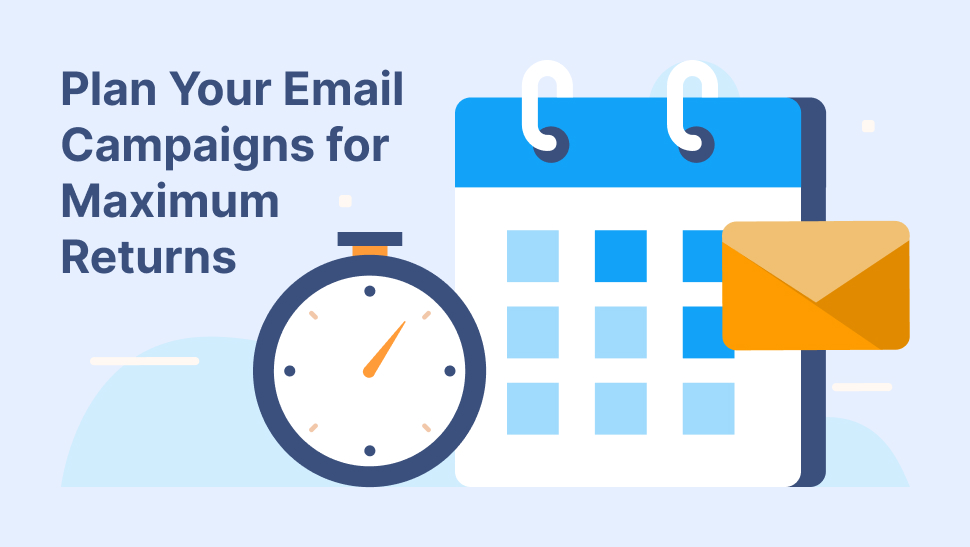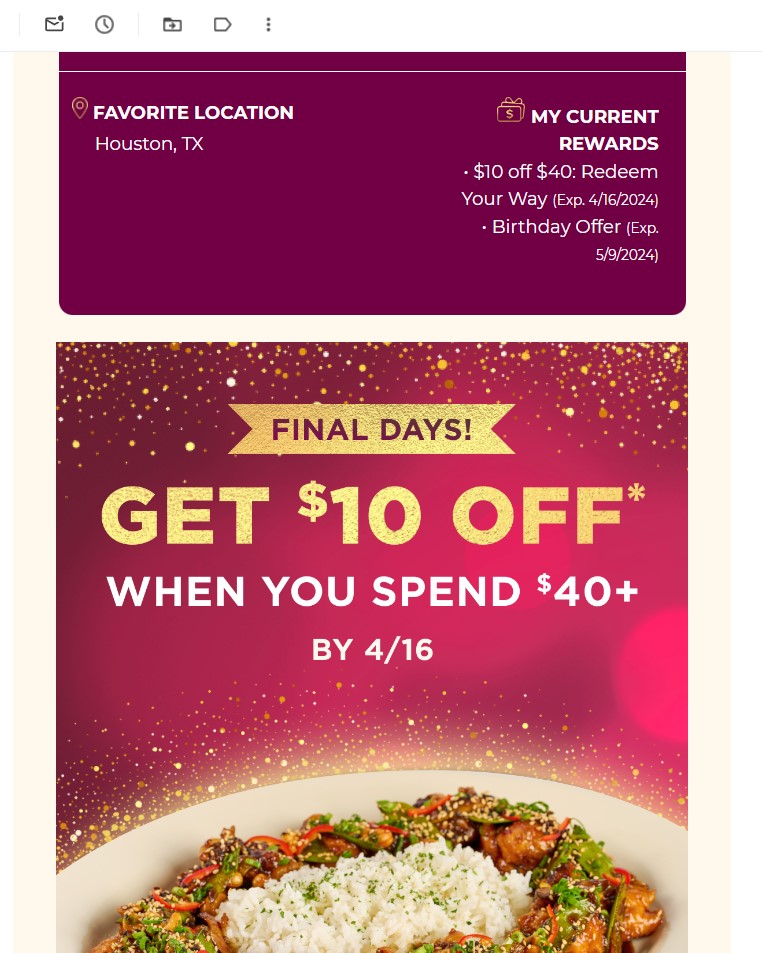Successful marketing is not an accident, but rather, the result of thoughtful planning and well-executed strategies. For business owners, marketers, and small company marketing teams, of all the tools available, one stands out due to its efficiency and effectiveness: The humble email.
Let's uncover some easy (and fun!) tips and strategies for planning out your email campaigns year-round. We can show you how these will help boost your engagement, lead conversion, and sales for your business all by planning ahead.
Table of Contents
- Steps to Planning Email Campaigns for Any Time of the Year
- Leverage the Expertise of a Digital Marketing Company
- Conclusion

Steps to Planning Email Campaigns for Any Time of the Year
Planning your email campaigns to coincide with different times of the year can be a game-changer in marketing. Why? Because it allows you to tap into the mindset of your consumers, using seasonal shifts and key calendar events to make your marketing message resonate even more. If you can align your marketing message with what's relevant in the lives of your consumers, you’re on your way to winning their hearts and their business.
You can begin to plan out your email campaigns and create them faster by choosing one of TruVISIBILITY's email templates. With a variety of templates created for high conversion rates, you're sure to find a time-relevant campaign that you can tweak to match your brand and message.
How can you effectively plan your email campaigns for any given time of the year? Let’s dive in to find out.
Map Out the Year
The first step in planning your year-round email campaigns involves mapping out the entire year. Starts by designating significant dates throughout the next 12 months on your marketing calendar. These dates aren't necessarily just traditional holidays like Christmas or Thanksgiving. They could be anything from seasonal changes, cultural events, local festivals, or even industry-specific events that your audience might have an interest in. The key lies in pinpointing the events and timeframes that relate most closely to your business and your target audience.
Example:
For instance, a B2B company might mark the dates of industry-specific conferences or expos, as these can drum up business and provide networking opportunities. On the other hand, a retail business might focus on peak shopping periods and seasonal trends such as Back To School, Black Friday, or Summer Sales.
Once you have your list, the brainstorming begins. How can these dates be woven into your marketing narrative to better connect with your audience? Perhaps you could tie a promotion in with the launch of the latest Bond movie if you know your demographic includes James Bond fans. Or maybe you could create a special offer around the summer solstice if your product somehow connects to outdoor living or wellness.
Each of these significant dates represents an opportunity to craft targeted, relevant email content that speaks directly to your recipients' interests and current focus. Maybe you can introduce a new product that's perfect for the changing seasons, offer a discount in honor of a cultural holiday, or simply share useful information that helps your customers gain more from your product or service during a particular time of the year.
This example email campaign from Brilliant Earth, an e-commerce jewelry store, uses Mother's Day to promote jewelry picked specifically for moms. Their target audience is, of course, people who need to get their mothers a gift for the holiday.

The aim here is to create a unique and compelling narrative for each significant date that will resonate with your audience, leading to higher open and click-through rates. Detailing these ideas next to each date on your mapped-out calendar will give you a clear, visual plan of action for the year ahead and ensure you’re always one step ahead with your email campaigns.
Engage with Seasonal Themes
When it comes to email marketing, there is an undeniable charm to seasonality. Embracing seasonal themes allows you to humanize your brand, create a more dynamic and appealing narrative, and increase the relevance of your emails. It's about syncing your communication style, visuals, and messaging with the changing moods, needs, and aspirations of your audience as the seasons shift and the calendar unfolds.
Incorporating seasonal themes doesn’t just mean changing your email template to reflect a holiday, such as adding pumpkins and ghostly figures for Halloween or snowflakes and twinkling lights for Christmas. It also involves reshaping your content and tailoring your offerings to the season at hand. An example could be sharing a series of energy-saving or cooling tips during the hot summer months if you’re an energy company, or a bookstore suggesting cozy winter reads as the temperatures drop.
Here are a few specific ways to engage with seasonal themes in your email campaigns:
Use Visual Elements: Deploy imagery and graphics that set the tone for the season. Winter might involve snowy landscapes and hot cocoa, while spring could mean flowers and clear, sunny skies.
Tailor Your Product Selection: Showcase the items or services in your range that are most relevant to the incoming season. If you sell clothing, the start of summer could mean heralding your new line of swimwear.
Write Seasonally-Inspired Content: Frame your emails with a nod to what's happening in the wider world. An email in autumn might speak of back-to-school routines and crisp, leafy days.
Offer Seasonal Promotions: Run promotions that tie in with seasonal festivities or events. For example, discounts to celebrate Valentine's Day, Mother's Day, Fourth of July, etc.
Use Seasonal Language: Use words and phrases that evoke the current season to draw readers in. Hot and sunny, crisp and breezy, cozy and warm – these seasonal cues help craft a relatable context for your messaging.
Share Seasonally Relevant Tips and Advice: If you’re in the home and garden industry, share gardening tips in the spring, home maintenance ideas in the fall, and indoor project suggestions in the winter.
Successfully leveraging seasonal themes makes your emails feel fresh, relevant, and in tune with your audience's current experiences and mindset, thus increasing the likelihood of engagement and conversion.
Personalize Your Messages
Remember that email campaigns offer a unique opportunity for one-to-one communication. The more personalized your emails are, the better. Tailoring email messages for specific audience segments. For instance, offers for those celebrating birthdays in a specific month, or recommendations based on past purchase behavior can significantly increase engagement rates.
Here are some strategies you can implement:
Segment Your List: Divide your email list into specific segments based on factors like demographics, purchasing behavior, interests, or location. Send different emails tailored to each segment.
Use the Recipient's Name: This is a basic yet essential step towards personalization. Use the recipient's name in the email subject line or greeting to capture their attention.
Celebrate Special Occasions: Send birthday or anniversary wishes, congratulate on a milestone, or celebrate holidays relevant to the recipient.
This example from The Cheesecake Factory is tailored specifically (automatically) to a recipient whose birthday is coming up.

Learn how you can send automated email blasts, such as birthday offers, with TruVISIBILITY's Messaging app.
Recommend Products Based on Past Purchases: Use customer purchase history to recommend products they may like or need. For instance, if they recently bought a camera, recommend a relevant accessory like a tripod or camera bag.
Send Replenishment Reminders: If your business involves products that are typically purchased repeatedly or used up, such as cosmetics or food items, remind your customers when it's time to restock based on their last purchase.
Tailor Content Based on Preferences: If you have information about your customers' interests, craft your email content accordingly. For example, if a customer has shown interest in a specific product category, provide content, news, or offers related to this category.
Follow Up on Abandoned Carts: Personalize reminder emails about items left in shopping carts. This can significantly increase the chances of the customer completing their purchase.
Geotarget Your Offers: Personalize your emails based on geographical location. You could send product suggestions based on local weather conditions, local events, or store-specific discounts and promotions.
Leverage User Activity: Personalize content based on the recipient's activity on your site. If they've been reading your blog, recommend other related articles or products.
Send Personalized Post-Purchase Emails: From thank you emails and requests for reviews to upsell and cross-sell suggestions, post-purchase email communication can significantly enhance customer experience and loyalty.
Each of these strategies gives your audience a sense of being understood and valued, leading to higher engagement and conversion rates.
Stay Relevant with Timely Content
Seasonal changes present an opportunity for businesses to stay relevant and in tune with their customers' evolving needs. As the calendar year progresses, shifts in climate, social activities, holidays, and even consumer sentiment play a significant role in shaping purchasing behavior. For example, an athletic wear company might capitalize on the New Year's resolution period by promoting their latest workout gear and fitness apparel in January, encouraging customers to start fresh with their health ambitions. Similarly, a tax preparation service might increase their communication in the weeks leading up to tax deadlines, offering advice, reassurances, and last-minute help.
Furthermore, it's important to consider regional variations. For businesses with a global outreach, winter in one hemisphere means summer in another. This requires a sophisticated segmentation strategy to ensure that your email content is relevant to the specific circumstances of your audience. A home improvement business, for instance, could send out tips for winter-proofing a house to customers in colder regions, while simultaneously targeting customers in warmer climates with ideas for outdoor renovations or landscaping projects.
Example:
During the holiday seasons, consumers are often on the lookout for gifts, decorations, or festive food and drink. Smart businesses anticipate this by tailoring their email marketing with gift guides, special holiday discounts, and exclusive offer previews. For instance, a makeup brand might create an email campaign around Mother's Day featuring a curated selection of products perfect for gifting, accompanied by tutorials for a Mother's Day brunch makeup look.
By analyzing trends from previous years, coupled with current market research, businesses can forecast upcoming demands and craft email content that is highly relevant and timely. Personalization can be taken a step further by including dynamic content within emails that changes based on the past behavior and preferences of the recipient, ensuring the content resonates on a personal level.
Plan Ahead, Leaving Room for Flexibility
Advanced planning of email campaigns is a hallmark of strategic marketing, allowing for thorough content creation, proofreading, design fine-tuning, and scheduling for optimal send times. Conceptualizing and preparing your email marketing efforts ahead of schedule will likely curb last-minute stress and provide ample time for team collaboration and feedback. Ensuring each detail of your campaign is meticulously crafted can be the difference between an email that gets opened and one that lands in the trash folder. Having a roadmap in place offers your team clarity and focus, streamlining your marketing initiatives toward cohesive goals.
However, digital content is ever-evolving, with trends as transient as the weather. As such, locking into an inflexible email strategy can be as perilous as ignoring planning altogether. External forces can rapidly influence consumer behavior, necessitating a marketing pivot to stay aligned with your audience's needs and sentiments. Real-world events, from global sports phenomena to rising socio-economic shifts, can drastically alter the playing field.
By building in the flexibility to adapt your content and messaging, you're safeguarding against the unpredictable and showing your audience that your brand is attentive and responsive to the world they live in. This agility can transform potential marketing challenges into opportunities to connect with your customers on a deeper level, ensuring that your brand remains relevant.
Test and Learn
Analyzing the performance of individual email campaigns is a critical step in understanding the effectiveness of your marketing strategy. By meticulously reviewing key metrics such as open rates, click-through rates, bounce rates, and ultimately, conversion rates, businesses can glean valuable insights into customer behavior and preferences.
Consider which subject lines led to the highest open rates: was it a question that prompted curiosity, a straightforward benefit statement, or perhaps the inclusion of the recipient's name? Identifying the characteristics of successful subject lines allows you to refine your approach for future communications, ensuring that your emails stand out in a crowded inbox.
Similarly, look at which emails had the highest engagement in terms of clicks and conversions. Did they contain a particular type of content, such as video tutorials, customer testimonials, or time-sensitive offers? Understanding which content formats and messaging resonate best with your audience is the key to crafting more compelling and effective campaigns.
Taking this analysis a step further and segmenting your data can reveal even more nuanced insights. You might find that certain email content performs better with specific demographics or that certain times of the day yield better engagement rates.
Leverage the Expertise of a Digital Marketing Company
As a business owner, you're expected to wear many hats. If mastering the art of seasonal email marketing seems a bit too overwhelming, partnering with a digital marketing company like TruVISIBILITY can be beneficial. We have the expertise and tools to develop, launch, and manage effective email campaigns designed to maximize engagement and ROI, no matter what time of year it is.
Conclusion
Campaigns timed with the calendar year are a powerful strategy for encouraging customer engagement and boosting sales. By planning ahead, staying relevant, and continuously learning from past campaigns, you can fully harness the potential of this strategy.
TruVISIBILITY's all-in-one digital marketing platform can do more than offer you a free tool to send email campaigns just as well as Mailchimp and other email applications. The seamless integration of email messaging with the website, chatbot, forms apps, and more helps you manage and improve engagement from your target audience. You can discover a load of tips and tricks on sending email campaigns year-round here or check out our support articles to learn how to fully utilize TruVISIBILITY's Messaging app.
Key Takeaways
1. Email marketing success hinges on strategic planning and aligning with consumer mindsets.
2. Seasonal themes and personalization in emails enhance engagement and conversion.
3. Flexibility and continuous analysis are key to effective email campaign strategies.
Small businesses, streamline your marketing with the TruVISIBILITY All-In-One Marketing Suite. Try it for free today and see the difference a unified platform makes!
Want to receive more articles?
Sign-up for our weekly newsletter to receive info that will help your business grow



